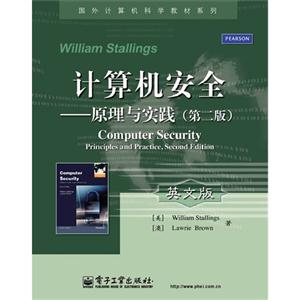-
>
全國計算機(jī)等級考試最新真考題庫模擬考場及詳解·二級MSOffice高級應(yīng)用
-
>
決戰(zhàn)行測5000題(言語理解與表達(dá))
-
>
軟件性能測試.分析與調(diào)優(yōu)實踐之路
-
>
第一行代碼Android
-
>
JAVA持續(xù)交付
-
>
EXCEL最強(qiáng)教科書(完全版)(全彩印刷)
-
>
深度學(xué)習(xí)
計算機(jī)安全-原理與實踐-(第二版)-英文版 版權(quán)信息
- ISBN:9787121200342
- 條形碼:9787121200342 ; 978-7-121-20034-2
- 裝幀:一般膠版紙
- 冊數(shù):暫無
- 重量:暫無
- 所屬分類:>
計算機(jī)安全-原理與實踐-(第二版)-英文版 本書特色
《國外計算機(jī)科學(xué)教材系列:計算機(jī)安全·原理與實踐(第2版)(英文版)》可作為高等院校相關(guān)專業(yè)計算機(jī)安全課程雙語教學(xué)的教材,同時也是一本有關(guān)密碼學(xué)和計算機(jī)網(wǎng)絡(luò)安全方面的非常有價值的參考書。
計算機(jī)安全-原理與實踐-(第二版)-英文版 內(nèi)容簡介
本書在上一版的基礎(chǔ)上進(jìn)行了修訂與更新,全面覆蓋了計算機(jī)安全領(lǐng)域的相關(guān)主題。全書共分為五個部分:**部分——計算機(jī)安全技術(shù)與原理,概述了支持有效安全策略所必需的技術(shù)領(lǐng)域;第二部分——軟件安全與可信系統(tǒng),講解了軟件開發(fā)和運行中的安全問題;第三部分——管理問題,主要討論信息與計算機(jī)安全在管理方面的問題;第四部分——密碼學(xué)算法,給出了各種類型的加密算法和其他類型的密碼算法;第五部分——網(wǎng)絡(luò)安全,重點分析了為網(wǎng)絡(luò)通信提供安全保障的協(xié)議和標(biāo)準(zhǔn)。本書思路清晰、結(jié)構(gòu)嚴(yán)謹(jǐn),并且提供了大量精心設(shè)計的實踐問題。
計算機(jī)安全-原理與實踐-(第二版)-英文版 目錄
chapter 0 reader's and instructor's guide
0.1 outline of this book
0.2 a roadmap for readers and instructors
0.3 support for cissp certification
0.4 internet and web resources
0.5 standards
chapter 1 overview
1.1 computer security concepts
1.2 threats, attacks, and assets
1.3 security functional requirements
1.4 a security architecture for open systems
1.5 computer security trends
1.6 computer security strategy
1.7 recommended reading and web sites
1.8 key terms, review questions, and problems
part one: computer security technology and principles
chapter 2 cryptographic tools
2.1 confidentiality with symmetric encryption
2.2 message authentication and hash functions
2.3 public-key encryption
2.4 digital signatures and key management
2.5 random and pseudorandom numbers
2.6 practical application: encryption of stored data
2.7 recommended reading and web sites
2.8 key terms, review questions, and problems
chapter 3 user authentication
3.1 means of authentication
3.2 password-based authentication
3.3 token-based authentication
3.4 biometric authentication
3.5 remote user authentication
3.6 security issues for user authentication
3.7 practical application: an iris biometric system
3.8 case study: security problems for atm systems
3.9 recommended reading and web sites
3.10 key terms, review questions, and problems
chapter 4 access control
4.1 access control principles
4.2 subjects, objects, and access rights
4.3 discretionary access control
4.4 example: unix file access control
4.5 role-based access control
4.6 case study: rbac system for a bank
4.7 recommended reading and web site
4.8 key terms, review questions, and problems
chapter 5 database security
5.1 the need for database security
5.2 database management systems
5.3 relational databases
5.4 database access control
5.5 inference
5.6 statistical databases
5.7 database encryption
5.8 cloud security
5.9 recommended reading and web site
5.10 key terms, review questions, and problems
chapter 6 malicious software
6.1 types of malicious software (malware)
6.2 propagation-infected content-viruses
6.3 propagation-vulnerability exploit-worms
6.4 propagation-social engineering-spam e-mail, trojans
6.5 payload-system corruption
6.6 payload-attack agent-zombie, bots
6.7 payload-information theft-keyloggers, phishing, spyware
6.8 payload-stealthing-backdoors, rootkits
6.9 countermeasures
6.10 recommended reading and web sites
6.11 key terms, review questions, and problems
chapter 7 denial-of-service attacks
7.1 denial-of-service attacks
7.2 flooding attacks
7.3 distributed denial-of-service attacks
7.4 application-based bandwidth attacks
7.5 reflector and amplifier attacks
7.6 defenses against denial-of-service attacks
7.7 responding to a denial-of-service attack
7.8 recommended reading and web sites
7.9 key terms, review questions, and problems
chapter 8 intrusion detection
8.1 intruders
8.2 intrusion detection
8.3 host-based intrusion detection
8.4 distributed host-based intrusion detection
8.5 network-based intrusion detection
8.6 distributed adaptive intrusion detection
8.7 intrusion detection exchange format
8.8 honeypots
8.9 example system: snort
8.10 recommended reading and web sites
8.11 key terms, review questions, and problems
chapter 9 firewalls and intrusion prevention systems
9.1 the need for firewalls
9.2 firewall characteristics
9.3 types of firewalls
9.4 firewall basing
9.5 firewall location and configurations
9.6 intrusion prevention systems
9.7 example: unified threat management products
9.8 recommended reading and web site
9.9 key terms, review questions, and prob
計算機(jī)安全-原理與實踐-(第二版)-英文版 作者簡介
William Stallings,擁有美國麻省理工學(xué)院計算機(jī)科學(xué)博士學(xué)位,現(xiàn)任教于澳大利亞新南威爾士大學(xué)國防學(xué)院(堪培拉)信息技術(shù)與電子工程系。他是世界知名計算機(jī)學(xué)者和暢銷教材作者,已經(jīng)撰寫了17部著作,出版了40多本書籍,內(nèi)容涉及計算機(jī)安全、計算機(jī)網(wǎng)絡(luò)和計算機(jī)體系結(jié)構(gòu)等方面,堪稱計算機(jī)界的全才。他曾九次榮獲美國“教材和學(xué)術(shù)專著作者協(xié)會”頒發(fā)的“年度最佳計算機(jī)科學(xué)教材”獎。
- >
二體千字文
- >
新文學(xué)天穹兩巨星--魯迅與胡適/紅燭學(xué)術(shù)叢書(紅燭學(xué)術(shù)叢書)
- >
史學(xué)評論
- >
伊索寓言-世界文學(xué)名著典藏-全譯本
- >
中國人在烏蘇里邊疆區(qū):歷史與人類學(xué)概述
- >
中國歷史的瞬間
- >
羅曼·羅蘭讀書隨筆-精裝
- >
自卑與超越
















